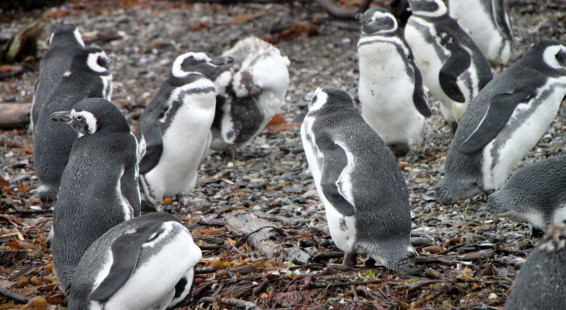
After our morning hike in Tierra del Fuego we returned to the Australis for lunch and some rest, during which time our ship re-positioned itself in Ainsworth Bay. Our afternoon excursion was to be entirely on a Zodiac. This is obviously a slower process than zipping us onshore for the morning’s hike as the supply of Zodiacs was limited.
The Zodiacs took us to a small cluster of islands known as Tucker’s Islets. These lie within the Strait of Magellan and are rich in bird life (note: Magellan was the Portuguese explorer who visited this region 500 years ago). We would slowly circle these islands in the Zodiac to observe the different types of birds, slowing to a stop when possible, but we did not land. A guides would explain what the birds were and their natural history to those on the Zodiac, and answer any questions that arose.

Getting a ride by zodiac to Tucker’s Islets
When one group of travelers completed their journey they returned to the Australisand the next group went out, and so on until over a period of several hours until everyone had experienced the birds up close. While we waited aboard the Australisfor our turn, we got to enjoy the scenery, watched dolphins and seals swimming by — even observed some albatrosses diving into the fjord. Best of all we were warm and dry, unlike those on the zodiacs caught in the afternoon’s drizzle and breezes. It’s a human instinct to seek warmth and to be dry, I think.
Finally our turn arrived and we were off, hats, rain-gear, life-jackets and all. Our first stop was to visit a group of Cormorants known as “red-faced shags” (also called Magellanic or Rock Cormorants). Adults and juveniles were resting by their nests on one of the cliffs just above us. Their red eye bands are quite striking. Apparently their tails are adapted to help with their balance on these rocky perches.

Red-faced shags (cormorants), Tucker’s Islets
The main attraction of the islets was a colony of Magellanic Penguins, where we spent most of our time. I’d seen these penguins on prior trips to the South America, but it’s always fun watching a group of them.
Magellanic penguins have a fairly wide-spread range along the coasts of South America. They are social creatures and stay together in flocks, including when they fish. They lay their eggs in nests (many within burrows) and can live up to 25 years. The penguins were obviously not very bothered by our presence.
We spent a fair bit of time observing the penguin colony — it’s hard not to like penguins. While anchored there, we also spotted a Chilean Skua (which hangs around the penguins in hopes of stealing one of their eggs) and kelp geese.
The cormorants were a rather chatty group of birds, and also fun to watch, as you can see below:
It was a fun and interesting excursion. As I’ve said many times, I enjoy birds, although don’t consider myself an avid birder. Still it was memorable to get close to birds we normally don’t see back home.
(Click on thumbnails to enlarge, right arrow to advance slideshow)